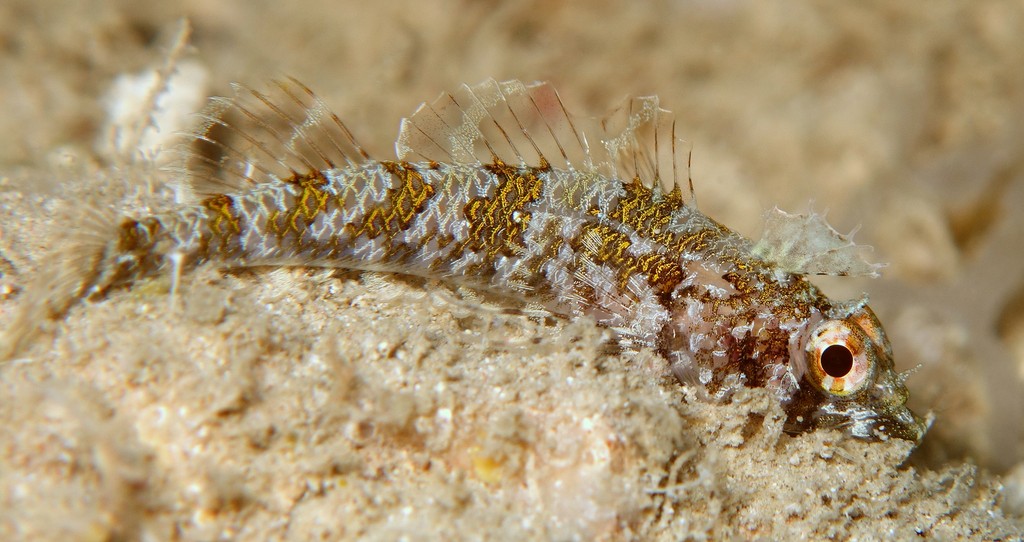NORFOLKIA THOMASI - (WHITLEY, 1964)
Picture courtesy of: Alain Daoulas
Actinopterygii (Gigaclass) > Actinopteri (Class) > Teleostei (Subclass) > Blenniiformes (Order) > Blennioidei (Suborder) > Tripterygiidae (Family) > Tripterygiinae (Subfamily) > Norfolkia (Genus)
Thomas' Threefin, Thomas' Triplefin, Buchi-nisehebiginpo, ブチニセヘビギンポ, 托氏諾福克鳚,
Description
First dorsal spines: 4; Dorsal spines (total): 13-16; Dorsal soft rays (total): 7-10 (usually: 11); Anal spines: 2; Anal soft rays: 20-25; Pectoral fin rays: 14-16 (usually: 15); Scales rows: 31-38 + 1; Transverse scale rows: 3.5-4.5 + 1 + 5.5-6.5; Lateral line scales: 10-15 + 0-1 + 18-28; Mandibular pore formula: 3 + 2 + 3. Head scaled forward to behind the eye, scales absent from cheek; Supraorbital tentacle lobate. Pectoral fin base and belly scaled. Lateral line consisting of an anterior series of 10-15 tubular pored scales, reaching about to below 11th-12th spine of second dorsal fin; Continuing two rows lower with a posterior series of 18-28 notched scales. One or two procurrent notched scales may occur in the same scale row. Anal fin beginning below vertical through about 5th membrane of second dorsal fin (about below 7th-8th lateral line pore). Pectoral fin reaching about to base of 12th-13th anal fin membrane. Max. length: 5.0 cm SL. Depth range: 1 - 20 m.
Color
A whitish triplefin with yellow to orange scale edges, six irregular oblique dark brown bands along the upper side that divide on the lower side, and an uneven white-edged brown bar below the eye. Females have narrow, oblique red and white bands on the second and third dorsal fins, while males have brownish-orange dorsal fins.
Etymology
Norfolkia: named for the Norfolk Island (Norfolk Island is a small island in the Pacific Ocean located between Australia, New Zealand and New Caledonia). In 1953 Henry W. Fowler named this new genus on a Collection of Fishes Made by Dr. Marshall Laird at Norfolk Island.
thomasi: named after Mr. Leonard Rees Thomas, organizer of the Australian Museum 1962 Swain Reefs Expedition.
Original description: Norfolkia thomasi Whitley, 1964 - Type locality: Heron Island, Capricorn Group, 23°26'S, 151°55'E, Queensland, Australia.
Distribution
Biology
Adults are found in coral reefs and intertidal pools. Eggs are hemispherical and covered with numerous sticky threads that anchor them in the algae on the nesting sites. Larvae are planktonic which occur primarily in shallow, nearshore waters.
Similar species
Norfolkia brachylepis (Schultz, 1960) - Reported from New Caledonia.
Norfolkia squamiceps (McCulloch & Waite, 1916) - Reported from New Caledonia. Differ in having the cheeks and the lower parts of the opercula scaleless and in having only 13 instead of 21 or more tubes along the lateral line, the upper part of which ceases below the eleventh spine in the second dorsal fin, instead of below the second dorsal interspace.
Actinopterygii (Gigaclass) > Actinopteri (Class) > Teleostei (Subclass) > Blenniiformes (Order) > Blennioidei (Suborder) > Tripterygiidae (Family) > Tripterygiinae (Subfamily) > Norfolkia (Genus)
Thomas' Threefin, Thomas' Triplefin, Buchi-nisehebiginpo, ブチニセヘビギンポ, 托氏諾福克鳚,
Description
First dorsal spines: 4; Dorsal spines (total): 13-16; Dorsal soft rays (total): 7-10 (usually: 11); Anal spines: 2; Anal soft rays: 20-25; Pectoral fin rays: 14-16 (usually: 15); Scales rows: 31-38 + 1; Transverse scale rows: 3.5-4.5 + 1 + 5.5-6.5; Lateral line scales: 10-15 + 0-1 + 18-28; Mandibular pore formula: 3 + 2 + 3. Head scaled forward to behind the eye, scales absent from cheek; Supraorbital tentacle lobate. Pectoral fin base and belly scaled. Lateral line consisting of an anterior series of 10-15 tubular pored scales, reaching about to below 11th-12th spine of second dorsal fin; Continuing two rows lower with a posterior series of 18-28 notched scales. One or two procurrent notched scales may occur in the same scale row. Anal fin beginning below vertical through about 5th membrane of second dorsal fin (about below 7th-8th lateral line pore). Pectoral fin reaching about to base of 12th-13th anal fin membrane. Max. length: 5.0 cm SL. Depth range: 1 - 20 m.
Color
A whitish triplefin with yellow to orange scale edges, six irregular oblique dark brown bands along the upper side that divide on the lower side, and an uneven white-edged brown bar below the eye. Females have narrow, oblique red and white bands on the second and third dorsal fins, while males have brownish-orange dorsal fins.
Etymology
Norfolkia: named for the Norfolk Island (Norfolk Island is a small island in the Pacific Ocean located between Australia, New Zealand and New Caledonia). In 1953 Henry W. Fowler named this new genus on a Collection of Fishes Made by Dr. Marshall Laird at Norfolk Island.
thomasi: named after Mr. Leonard Rees Thomas, organizer of the Australian Museum 1962 Swain Reefs Expedition.
Original description: Norfolkia thomasi Whitley, 1964 - Type locality: Heron Island, Capricorn Group, 23°26'S, 151°55'E, Queensland, Australia.
Distribution
Western Pacific: New Caledonia, Queensland (Australia) and southern Pacific east to Rapa; Amami Islands (southern Japan)
Biology
Adults are found in coral reefs and intertidal pools. Eggs are hemispherical and covered with numerous sticky threads that anchor them in the algae on the nesting sites. Larvae are planktonic which occur primarily in shallow, nearshore waters.
Similar species
Norfolkia brachylepis (Schultz, 1960) - Reported from New Caledonia.
Norfolkia squamiceps (McCulloch & Waite, 1916) - Reported from New Caledonia. Differ in having the cheeks and the lower parts of the opercula scaleless and in having only 13 instead of 21 or more tubes along the lateral line, the upper part of which ceases below the eleventh spine in the second dorsal fin, instead of below the second dorsal interspace.
Last update: 11, June 2022
